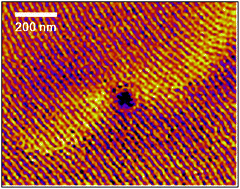Suppression of target patterns in domain aligned cold-zone annealed block copolymer films with immobilized film-spanning nanoparticles
Abstract
We examine the effect of a moving in-plane temperature gradient on the ordering of cylinder-forming block-copolymers (BCP) in films containing immobilized nanoparticles that span the film thickness. In a previous paper, we reported the effect of static step oven-annealing of these films above the glass transition temperature Tg for a long period before ordering the BCP film at a much higher temperature. In the dynamic film annealing method of the present work, termed cold zone annealing (CZA), the material is continuously raised to a temperature somewhat above the glass transition temperature and then well above it, with a control of the heating time and thermal gradient. Oven annealing before ordering has been found to relieve residual stresses in the film associated with large thermal expansion of the film upon heating, eliminating the large scale target patterns induced by stresses effects associated with residual solvent and thermal expansion. By comparison, CZA naturally suppresses undesirable target patterning with enhanced ordering kinetics created through this thermal history.


 Please wait while we load your content...
Please wait while we load your content...